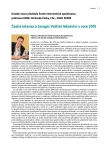Tachycardia-induced cardiomyopathy
Authors:
Jan Povolný
Authors‘ workplace:
Kardiocentrum, III. interní kardiologická klinika 3. LF UK a FN Královské Vinohrady Praha, přednosta prof. MUDr. Petr Widimský, DrSc., FESC, FACC
Published in:
Vnitř Lék 2015; 61(1): 56-59
Category:
Reviews
Overview
Cardiomyopathy is a heterogeneous group of diseases of heart muscle accompanied with impaired cardiac function. Tachycardia-induced cardiomyopathy (TIC) is caused by prolonged tachycardia leading to dilatation and systolic dysfunction with clinical manifestation of heart failure. This state is reversible after normalization of heart rate. The diagnosis is usually made retrospectively after normalization of heart rate and recovery of left ventricular function (LVF). More than 100 years after the first documented case (described in 1913 in a young patient with atrial fibrillation and symptoms of heart failure [25]) is still limited knowledge of pathophysiological mechanisms. The most common arrhythmias responsible for the TIC include atrial fibrillation [1,2], atrial flutter [3], incessant supraventricular tachycardia [4], ventricular tachycardia (VT) [5] and frequent ventricular extrasystoles (VES) [6]. TIC detection and therapeutic intervention is crucial considering potential reversibility of tachycardia. Current options of treatment involve drug therapy and surgical or catheter ablation.
Key words:
heart failure – reversible dysfunction – tachycardia-induced cardiomyopathy
Sources
1. Grogan M, Smith HC, Gersh BJ et al. Left ventricular dysfunction due to atrial fibrillation in patients initially believed to have idiopathic dilated cardiomyopathy. Am J Cardiol 1992; 69(19): 1570–1573.
2. Raymond RJ, Lee AJ, Messineo FC et al. Cardiac performance early after cardioversion from atrial fibrillation. Am Heart J 1998; 136(3): 435–442.
3. Luchsinger JA, Steinberg JS. Resolution of cardiomyopathy after ablation of atrial flutter. J Am Coll Cardiol 1998; 32(1): 205–210.
4. Cruz FE, Cheriex EC, Smeets JL et al. Reversibility of tachycardia-induced cardiomyopathy after cure of incessant supraventricular tachycardia. J Am Coll Cardiol 1990; 16(3): 739–744.
5. Jaggarao NS, Nanda AS, Daubert JP. Ventricular tachycardia induced cardiomyopathy: improvement with radiofrequency ablation. Pacing Clin Electrophysiol 1996; 19(4 Pt 1): 505–508.
6. Chugh SS, Shen WK, Luria DM et al. First evidence of premature ventricular complex-induced cardiomyopathy: a potentially reversible cause of heart failure. J Cardiovasc Electrophysiol 2000; 11(3): 328–329.
7. Whipple GH, Sheffield LT, Woodman EG et al. Reversible congestive heart failure due to chronic rapid stimulation of the normal heart. Proc N Engl Cardiovasc Soc 1962; 20 : 39–40.
8. O’Brien PJ, Ianuzzo CD, Moe GW et al. Rapid ventricular pacing of dogs to heart failure: biochemical and physiological studies. Can J Physiol Pharmacol 1990; 68(1): 34–39.
9. Spinale FG, Clayton C, Tanaka R et al. Myocardial Na+, K(+) - ATPase in tachycardia induced cardiomyopathy. J Mol Cell Cardiol 1992; 24(3): 277–294.
10. Calderone A, Bouvier M, Li K et al. Dysfunction of the beta and alpha-adrenergic systems in a model of congestive heart failure. The pacing-overdrive dog. Circ Res 1991; 69(2): 332–343.
11. Perreault CL, Shannon RP, Komamura K et al. Abnormalities in intracellular calcium regulation and contractile function in myocardium from dogs with pacing-induced heart failure. J Clin Invest 1992; 89(3): 932–938.
12. Damiano jr. RJ, Tripp jr. HF, Asano T et al. Left ventricular dysfunction and dilatation resulting from chronic supraventricular tachycardia. J Thorac Cardiovasc Surg 1987; 94(1): 135–143.
13. Kajstura J, Zhang X, Liu Y et al. The cellular basis of pacing-induced dilated cardiomyopathy. Myocyte cell loss and myocyte cellular reactive hypertrophy. Circulation 1995; 92(8): 2306–2317.
14. Spinale FG, Grine RC, Tempel GE et al. Alterations in the myocardial capillary vasculature accompany tachycardia-induced cardiomyopathy. Basic Res Cardiol 1992; 87(1): 65–79.
15. Ohno M, Cheng CP, Little WC. Mechanism of altered patterns of left ventricular filling during the development of congestive heart failure. Circulation 1994; 89(5): 2241–2250.
16. Tibayan FA, Lai DT, Timek TA et al. Alterations in left ventricular torsion in tachycardia-induced dilated cardiomyopathy. J Thorac Cardiovasc Surg 2002; 124(1): 43–49.
17. Zellner JL, Spinale FG, Eble DM et al. Alterations in myocyte shape and basement membrane attachment with tachycardia-induced heart failure. Circ Res 1991; 69(3): 590–600.
18. Riegger AJ, Liebau G. The renin-angiotensin-aldosterone system, antidiuretic hormone and sympathetic nerve activity in an experimental model of congestive heart failure in the dog. Clin Sci (Lond) 1982; 62(5): 465–469.
19. Howard RJ, Stopps TP, Moe GW et al. Recovery from heart failure: structural and functional analysis in a canine model. Can J Physiol Pharmacol 1988; 66(12): 1505–1512.
20. Tomita M, Spinale FG, Crawford FA et al. Changes in left ventricular volume, mass, and function during the development and regression of supraventricular tachycardia-induced cardiomyopathy. Disparity between recovery of systolic versus diastolic function. Circulation 1991; 83(2): 635–644.
21. Stewart S, Hart CL, Hole DJ et al. A population-based study of the long-term risks associated with atrial fibrillation: 20-year follow-up of the Renfrew/Paisley study. Am J Med 2002; 113(5): 359–364.
22. Chiladakis JA, Vassilikos VP, Maounis TN et al. Successful radiofrequency catheter ablation of automatic atrial tachycardia with regression of the cardiomyopathy picture. Pacing Clin Electrophysiol 1997; 20(4 Pt 1): 953–959.
23. Baman TS, Lange DC, Ilg KJ et al. Relationship between burden of premature ventricular complexes and left ventricular function. Heart Rhythm 2010; 7(7): 865–869.
24. Deyell MW, Park KM, Han Y et al. Predictors of recovery of left ventricular dysfunction after ablation of frequent ventricular premature depolarizations. Heart rhythm 2012; 9(9): 1465–1472.
25. Gossage AM, Braxton Hicks JA. On auricular fibrillation. QJ Med 1913; 6(4): 435–440.
Labels
Diabetology Endocrinology Internal medicineArticle was published in
Internal Medicine

2015 Issue 1
Most read in this issue
- Therapeutic monitoring of amikacin and gentamicin in routine clinical practice
- Association between asymptomatic hyperuricaemia and metabolic syndrome in the adolescents
- Tachycardia-induced cardiomyopathy
- The role of the assessment of heavy/light chain pairs of immunoglobulin in monoclonal gammopathies
